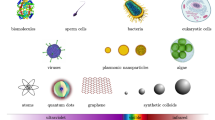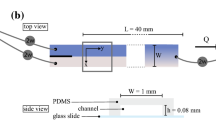Abstract
In microscale particle velocimetry, the spatial resolution of velocity measurements along the optical axis is often degraded by signal from tracer particles outside the focal plane. Structured illumination microscopy particle tracking velocimetry (SIM PTV) can eliminate most of this out-of-focus signal by using illumination with a non-zero spatial frequency to preferentially illuminate the in-focus particles. Two such (raw) images can then be combined to eliminate the background signal and demodulate the image. The objective of this study was to quantify and optimize the spatial and temporal resolution of SIM PTV based upon Poiseuille flow in a microchannel at Reynolds numbers Re ≈ 0.02. The axial spatial resolution, estimated for this known velocity profile from the standard deviation of the velocity measurements, is improved by at least a factor of 2 compared with the results for a uniformly illuminated flow. This axial spatial resolution is in good agreement with that given by the point spread function of the imaging system derived by Neil et al. (Neil et al., Opt Lett 22:1905–1907, 1997). The spatial frequency of the illumination that optimizes the spatial resolution is a function of the scattering area of the tracer particles. Interestingly, increasing the number of raw images does not appear to improve the axial resolution. Finally, the temporal resolution of SIM PTV is estimated based upon both image and velocity acquisition times.
Graphical abstract









Similar content being viewed by others
Availability of data and materials
The data used for this study are available from the corresponding author upon reasonable request by email.
References
Adrian RJ (2005) Twenty years of particle image velocimetry. Exp Fluids 39(2):159–169
Bohren CF, Huffman DR (2008) Absorption and scattering of light by small particles. John Wiley & Sons
Chakrova N, Rieger B, Stallinga S (2016) Deconvolution methods for structured illumination microscopy. J Opt Soc Am A 33(7):B12–B20
Chan TF, Vese LA (2001) Active contours without edges. IEEE Trans Image Process 10(2):266–277
Chasles F, Dubertret B, Boccara AC (2007) Optimization and characterization of a structured illumination microscope. Opt Express 15(24):16130–16140
Frantz D, Karamahmutoglu T, Schaser AJ, Kirik D, Berrocal E (2022) High contrast, isotropic, and uniform 3D-imaging of centimeter-scale scattering samples using structured illumination light-sheet microscopy with axial sweeping. Biomed Opt Express 13(9):4907–4925
Gao Y, Chen L (2008) Versatile control of multiphase laminar flow for in-channel microfabrication. Lab Chip 8(10):1695–1699
Klein SA, Moran JL, Frakes DH, Posner JD (2012) Three-dimensional three-component particle velocimetry for microscale flows using volumetric scanning. Meas Sci Technol 23(8):085304
Kristensson E, Berrocal E (2018) Crossed patterned structured illumination for the analysis and velocimetry of transient turbid media. Sci Rep 8(1):1–9
Lee SJ, Kim S (2009) Advanced particle-based velocimetry techniques for microscale flows. Microfluid Nanofluid 6(5):577–588
Li Y, Diddens C, Segers T, Wijshoff H, Versluis M, Lohse D (2020) Rayleigh–Taylor instability by segregation in an evaporating multicomponent microdroplet. J Fluid Mech 899
Lukosz W (1966) Optical systems with resolving powers exceeding the classical limit. J Opt Soc Am 56(11):1463–1471
Meng Y, Lin W, Li C, Chen SC (2017) Fast two-snapshot structured illumination for temporal focusing microscopy with enhanced axial resolution. Opt Express 25(19):23109–23121
Mishra YN, Kristensson E, Koegl M, Jönsson J, Zigan L, Berrocal E (2017) Comparison between two-phase and one-phase SLIPI for instantaneous imaging of transient sprays. Exp Fluids 58(9):1–17
Neil MA, Juškaitis R, Wilson T (1997) Method of obtaining optical sectioning by using structured light in a conventional microscope. Opt Lett 22(24):1905–1907
Otsu N (1979) A threshold selection method from gray-level histograms. IEEE Trans Syst Man Cybern 9(1):62–66
Shang L, Cheng Y, Zhao Y (2017) Emerging droplet microfluidics. Chem Rev 117(12):7964–8040
Shields CW IV, Reyes CD, López GP (2015) Microfluidic cell sorting: a review of the advances in the separation of cells from debulking to rare cell isolation. Lab Chip 15(5):1230–1249
Sigal YM, Zhou R, Zhuang X (2018) Visualizing and discovering cellular structures with super-resolution microscopy. Science 361(6405):880–887
Spadaro M, Yoda M (2020) Structured illumination microscopy: a new way to improve the axial spatial resolution of microscale particle velocimetry. Exp Fluids 61(6):1–8
Xi P (2014) Optical nanoscopy and novel microscopy techniques, pp 39–40, CRC Press.
Yeo LY, Chang HC, Chan PP, Friend JR (2011) Microfluidic devices for bioapplications. Small 7(1):12–48
Yoda M (2020) Super-resolution imaging in fluid mechanics using new illumination approaches. Annu Rev Fluid Mech 52:369–393
Zhang B, Zerubia J, Olivo-Marin JC (2007) Gaussian approximations of fluorescence microscope point-spread function models. Appl Opt 46(10):1819–1829
Zhou X, Lei M, Dan D, Yao B, Qian J, Yan S, Chen G (2015) Double-exposure optical sectioning structured illumination microscopy based on Hilbert transform reconstruction. PLoS ONE 10(3):e0120892
Acknowledgements
This work was supported by the American Chemical Society Petroleum Research Fund (Grant 57789-ND9) and the Mechanical Sciences Branch of the US Army Research Office (Contract No. W911NF-17-1-0389).
Funding
This work was supported by the American Chemical Society Petroleum Research Fund (Grant 57789-ND9) and the Mechanical Sciences Branch of the US Army Research Office (Contract No. W911NF-17–1-0389).
Author information
Authors and Affiliations
Contributions
M. S. and M. Y. contributed to the design and planning of the experiments. M. S. carried out the experiments. M. S. and M. Y. contributed to the analysis and discussion of the results, writing and revising the manuscript, and designing the figures.
Corresponding author
Ethics declarations
Ethical approval
Not applicable.
Competing interests
The authors declare that they have no financial or commercial competing interests.
Rights and permissions
Springer Nature or its licensor (e.g. a society or other partner) holds exclusive rights to this article under a publishing agreement with the author(s) or other rightsholder(s); author self-archiving of the accepted manuscript version of this article is solely governed by the terms of such publishing agreement and applicable law.
About this article
Cite this article
Spadaro, M., Yoda, M. Resolution considerations for structured illumination microscale particle tracking velocimetry. Exp Fluids 64, 33 (2023). https://doi.org/10.1007/s00348-022-03563-x
Received:
Revised:
Accepted:
Published:
DOI: https://doi.org/10.1007/s00348-022-03563-x




